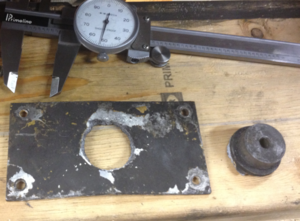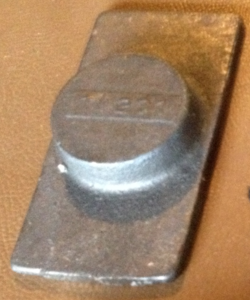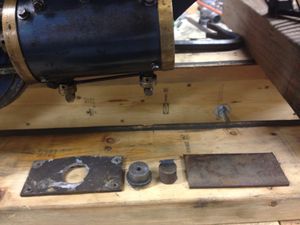Allen Mogul Pony Pivot Repair: Difference between revisions
No edit summary |
No edit summary |
||
| Line 5: | Line 5: | ||
I heard stories about how much maintenance goes into a live steam locomotive. Now that I'm an owner I am finding that I have to do some kind of repair or maintenance following almost every run. Most of what I have done has been to improve operation or change operation to my preference. But #486 experienced some real damage on a run at the [[Annetta Valley & Western Railroad]] during a recent run. | I heard stories about how much maintenance goes into a live steam locomotive. Now that I'm an owner I am finding that I have to do some kind of repair or maintenance following almost every run. Most of what I have done has been to improve operation or change operation to my preference. But #486 experienced some real damage on a run at the [[Annetta Valley & Western Railroad]] during a recent run. | ||
== The Incident == | |||
A cool front blew through north Texas August 17, 2013. It was the first break in the heat all summer, so I took advantage of the opportunity. I made the first run on the track that morning. Unfortunately, the track had not been "walked", and as #486 began its climb out of [[Bob_Grey#Stamey_Loop|Stamey Loop]] I noticed a 1/2 inch stick across the rails. I didn't have time to stop, and hoped the cow-catcher would throw the stick clearn of the tracks. Well, it didn't, and old #486 went right over it. The pony truck went right over it, followed by all six drivers. They didn't event derail! But the tender did, so I stopped to clear the track and re-rail. All seemed find, but I found that the pony truck kept derailing in curves. Another engineer passing by pointed out that #486's pony truck was not tracking straight. I got down on my hands and knees and noticed the pony truck pivot pin was missing. | A cool front blew through north Texas August 17, 2013. It was the first break in the heat all summer, so I took advantage of the opportunity. I made the first run on the track that morning. Unfortunately, the track had not been "walked", and as #486 began its climb out of [[Bob_Grey#Stamey_Loop|Stamey Loop]] I noticed a 1/2 inch stick across the rails. I didn't have time to stop, and hoped the cow-catcher would throw the stick clearn of the tracks. Well, it didn't, and old #486 went right over it. The pony truck went right over it, followed by all six drivers. They didn't event derail! But the tender did, so I stopped to clear the track and re-rail. All seemed find, but I found that the pony truck kept derailing in curves. Another engineer passing by pointed out that #486's pony truck was not tracking straight. I got down on my hands and knees and noticed the pony truck pivot pin was missing. | ||
| Line 13: | Line 15: | ||
The OEM part that had broken was [[Allen Models of Michigan|Allen Models]] #201, "Center Plate". It is a cast aluminum cover for the bottom of the saddle. The casting includes a pivot point for the pony truck. This cylindrical pivot is what broke completely off during the impact with the branch. | The OEM part that had broken was [[Allen Models of Michigan|Allen Models]] #201, "Center Plate". It is a cast aluminum cover for the bottom of the saddle. The casting includes a pivot point for the pony truck. This cylindrical pivot is what broke completely off during the impact with the branch. | ||
== The Repair == | |||
I decided to manufacture my own "Center Plate" from steel components, mainly because I did not want to wait for a replacement part. I also wanted a stronger material than cast aluminum. I also decided to reduce the diameter of the pivot so the pony truck would have more vertical freedom. | I decided to manufacture my own "Center Plate" from steel components, mainly because I did not want to wait for a replacement part. I also wanted a stronger material than cast aluminum. I also decided to reduce the diameter of the pivot so the pony truck would have more vertical freedom. | ||
The photos below show how I made the replacement parts. | The photos below show how I made the replacement parts. | ||
<gallery widths="300px" heights="300px"> | |||
File:CenterPlateCastingBroken.png|Broken center plate casting from Allen Mogul #486 after driving over 1/2 inch stick. Photos by Daris A. Nevil. | |||
File:CenterPlateCasting201.png|An un-machined casting, #201 "Center Plate", from Allen Models of Michigan. | |||
File:CenterPlateCasting with ReplacementSteelComponents.jpg|A broken #201 casting next to new steel components to be used to fabricate replacement on Allen Mogul #486. The pivot point is cut from 3/4 inch [[CRS]]. I used an abrasive chop saw to rough cut 0.6 inch length part. Cut a 4 inch length of 2 inch by 1/8 inch HRS steel for the plate. | |||
</gallery> | |||
Revision as of 23:19, 12 October 2013
by Daris A. Nevil
I heard stories about how much maintenance goes into a live steam locomotive. Now that I'm an owner I am finding that I have to do some kind of repair or maintenance following almost every run. Most of what I have done has been to improve operation or change operation to my preference. But #486 experienced some real damage on a run at the Annetta Valley & Western Railroad during a recent run.
The Incident
A cool front blew through north Texas August 17, 2013. It was the first break in the heat all summer, so I took advantage of the opportunity. I made the first run on the track that morning. Unfortunately, the track had not been "walked", and as #486 began its climb out of Stamey Loop I noticed a 1/2 inch stick across the rails. I didn't have time to stop, and hoped the cow-catcher would throw the stick clearn of the tracks. Well, it didn't, and old #486 went right over it. The pony truck went right over it, followed by all six drivers. They didn't event derail! But the tender did, so I stopped to clear the track and re-rail. All seemed find, but I found that the pony truck kept derailing in curves. Another engineer passing by pointed out that #486's pony truck was not tracking straight. I got down on my hands and knees and noticed the pony truck pivot pin was missing.
By this time I was far from the engine stands. The same helpful engineer suggested I run backwards back to Terry Town Station. That worked like a charm, and I didn't derail anymore.
Upon closer inspection I realized that not only was the pivot pin missing, but the pivot bearing had broken off.
The OEM part that had broken was Allen Models #201, "Center Plate". It is a cast aluminum cover for the bottom of the saddle. The casting includes a pivot point for the pony truck. This cylindrical pivot is what broke completely off during the impact with the branch.
The Repair
I decided to manufacture my own "Center Plate" from steel components, mainly because I did not want to wait for a replacement part. I also wanted a stronger material than cast aluminum. I also decided to reduce the diameter of the pivot so the pony truck would have more vertical freedom.
The photos below show how I made the replacement parts.
A broken #201 casting next to new steel components to be used to fabricate replacement on Allen Mogul #486. The pivot point is cut from 3/4 inch CRS. I used an abrasive chop saw to rough cut 0.6 inch length part. Cut a 4 inch length of 2 inch by 1/8 inch HRS steel for the plate.


